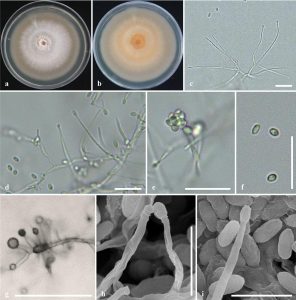Emericellopsis koreana Hyang B. Lee, S.J. Jeon & T.T.T. Nguyen
Index Fungorum number: IF554458; Facesoffungi number: FoF05732
Etymology: Named after the country where it was collected, Korea.
Holotype: CNUFC-MOG1-1
Sexual morph Undetermined. Asexual morph Hyphomycetous observed from MEA, acremonium-like. Mycelia consisting of hyaline, smooth-walled, septate hyphae, single or in bundles. Conidiophores mostly simple and orthotropic. Conidiogenous cells (15.5–)31.5–40(–59) µm long, tapering from 2(–2.5) µm at the base to 0.5 µm at the apex. Conidia ellipsoid or oblong-ellipsoid, smooth-surfaced, 3–4(–5) × 1.5–2(–2.5) µm (n = 50), hyaline, adhering in slimy heads. No chlamydospores observed.
Culture characteristics: The isolate grows over a wide range of temperatures with varying growth rates. The average growth rates of CNUFC-MOG1-1 on MEA, CYA, and PDA medium at 25 °C were 27.5, 17, and 15.5 mm after 7 days, respectively. Optimal growth was observed around 25 °C, slow growth was observed below 10 °C, and no growth at 40 °C.
Material examined: REPUBLIC OF KOREA, Jeonnam Province, the garden of the Chonnam National University located in Gwangju (35°10’20.2”N 126°53′57.2″E), from the gut of a mosquito larva, 15 September 2016, H.B. Lee, CNUFC-MOG1-1 (holotype), ex-type living culture, JMRC: SF:013604.
GenBank numbers: ITS = MH173304, TUB2 = MH243035 (CNUFC-MOG1-1); ITS = MH173305, TUB2 = MH243036 (CNUFC-MOG1-2).
Notes: Emericellopsis koreana, which forms a subclade with E. donezkii Beliakova, E. humicola (Cain) Cain ex Grosklags & Swift, E. persica Papizadeh et al. and Emericellopsis sp., differs by having smaller conidia. In the phylogenetic tree based on a combined ITS and TUB2 sequence dataset, the strains CNUFC-MOG1-1 and CNUFC-MOG1-2 form a separate branch from other related species of Emericellopsis and is considered to be a new species.

Figure 1. Emericellopsis koreana (CNUFC-MOG1-1, holotype). a, b Colonies on malt extract agar (MEA) (a: obverse view, b: reverse view). c Conidiophores with branched form in the basal region (LM). d, g Unbranched conidiophores, conidial heads (LM). e, f Conidia on slimy head and single conidia (LM). g–i Curved or straight conidiophore and ellipsoid or oblong-ellipsoid conidia (SEM). Scale bars c–g = 20 µm, h = 4 µm, i = 5 µm
